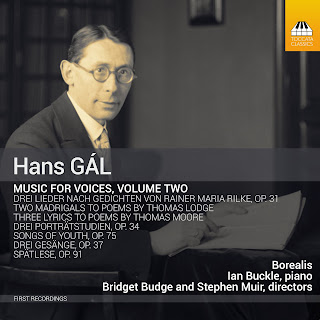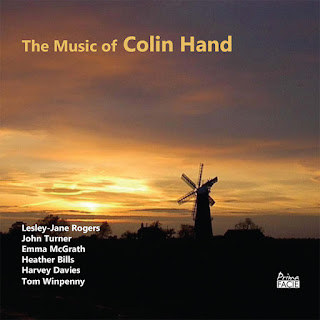On 10 January 1924, the American
magazine, Musical Courier carried a length pen portrait of the English
Composer Arnold Bax. The author, John F. Porte (1901-1941) was a London based
author and music critic. He regularly contributed articles to the Musical
Courier and many other leading music journals. He published books about
Edward MacDowell and Chopin as well as catalogues of the music of Edward Elgar
and Charles Villiers Stanford.
The present essay discusses Bax
when he was 41 years old, so he was a mature composer. The reader will note
that there is no reference to the Symphonies. The first one (of seven) had been
heard in London on 2 December 1922, so Porte should have been aware of it. The
Second was not completed until 1926. In the first post of this article, Porte
gives an overview of Bax’s life up to that point, followed by a brief
discussion of his orchestral works. It concludes with some remarks about Impressionism
in Bax’s music and a few notes about the choral music.
I have silently made a few minor corrections.
Arnold Bax, that curiously
reticent figure in modern British music, presents a discussive attraction
that comes but slowly. Born in London on November 8, 1883, his career so far
has been, in the even tenor of its way, a contrast to the inspiringly romantic
journeys to success of his fellow-countrymen, Elgar and Holst. In his early
youth he showed distinct musical gifts, and entered, in 1900, the Royal Academy
of Music, London. Here he studied the pianoforte with Tobias Matthay, a
distinguished teacher who now has his own pianoforte school in London, and
composition with Frederick Corder, a composer and well-known authority on the
orchestra.
After five years Bax left the
R.A.M. in possession of a complete equipment in musical technic, but with his
personality, as is now observed, free. It is, indeed, hard to imagine this
elusive poet of music in the harness of academic routine.
As I have indicated, the career
of Arnold Bax is even and unobtrusive, and this is something of a reflection of
the personality of the man. Retiring and unassuming, he is not of the
unapproachable type, but may rather be described as not easily accessible. We
may read much of the man in his music, where we find an initial reticence that
afterwards makes it all the more interesting. He has a deep interest in the
dreamland of Celtic legendry, and certain of his music expresses this. A
further predilection for things of the past is his interest in old English and
French folksongs.
Yet his views on musical
composition are thoroughly modern, for no academic restrictions could be
allowed to shackle his poetical expressions.
As a pianist, Bax has made public
appearances on several occasions, mostly in conjunction with a singer or
instrumentalist for performances of his own works. He is a capable, but not
outstanding, player and does not occupy a position comparable with the
composer-pianists, Percy Grainger and Cyril Scott. Apart from the appearances
referred to, the public has seen little of him.
The performances of works by Bax
have been growing in number of late, but I doubt whether he will ever achieve
popularity among the musical public. Of course, a group of admirers stand by him
and laud his works, but this is perhaps not of great value when we consider
that he is welcomed by many as an addition to the modernist group of composers.
The enthusiasts for thoroughly modern music are rather apt to welcome all
recruits for the cause, whether they have any chance of success outside their
own circle or not, However, Bax is making his way into the programs of
first-class concerts. His fame is spreading beyond the confines of his own
country, and it will be all the more enduring for having been courted with an
inherent delicacy and restraint that makes the possessor one of the most
sympathetic figures in contemporary British music. Both the personality and the
music of Arnold Bax are incapable of self-advertisement.
The Works of BaxThe compositions of Arnold Bax embrace orchestral and choral works, ballets, various chamber music and songs. There is no classification of them by that convenient indicator of period, the opus number. The orchestral works, from the first example, express by their titles the poetical, imaginative trend of their composer’s thought. Indeed, the early piece, Into the Twilight, gives us a titular indication of the kind of journey on which we are taken with the majority of Bax’s music
Passing these characteristic, but
generally immature and over-elaborated numbers (In the Faery Hills, Festival
Overture, Christmas Eve on the Mountains, a suite of four orchestral
pieces (a) Pensive Twilight, (b) Dance in The Sun, (c) From
the Mountains at Home, (d) Dance of Wild Irravel and Nympholept),
we pause at Spring-Fire, a rather more clear impression than the
foregoing. A Scherzo, first performed by Sir Henry J. Wood, September 3, 1919,
at a Queens Hall promenade concert, is between this and the next work, The
Garden of Fand, where we meet the composer discarding superfluity, leaving
a complex idiom that flows naturally, if not at once eloquently, for we are
reminded of the fact that all of Bax’s music requires a closely sympathetic
attention. The piece needs a great refinement of interpretation, and recent
performances have indicated that it presents a finely painted impression.
Other orchestral compositions of
Bax include the expressive In Memoriam; the strong, often-played Tintagel,
which many people think harsh and strange; and Mediterranean, the
orchestral version of a pianoforte piece.
Other orchestral compositions of
Bax include the expressive In Memoriam; the strong, often-played Tintagel,
which many people think harsh and strange; and Mediterranean, the
orchestral version of a pianoforte piece.
An ImpressionistThe most important of Bax’s orchestral works up to the present is probably November Woods. This remarkable orchestral tone-picture, with its acceptance of Nature in her bleak sombreness, devoid of the fragrant perfumes of beautiful gardens, is undoubtedly the work of an impressionist having moods that are deep and sensitive. With November Woods the fame of Bax rose to a higher level than it had hitherto reached.
The Symphonic Variations
in E, for pianoforte and orchestra, have met with some approval. An interesting
example of a modern concerto, they should be heard and digested as the work of
a very skilled musician, although not that of a genius. They were first played
on November 23, 1920, by Harriet Cohen at a Queens Hall promenade concert. The
same artist has played them several times since.
The choral music of Bax has only
lately come into prominence, and perhaps no sooner than possible, for it is
only the recently issued works of his in this form that are outstanding.
The first of these high watermark
works that claims our attention is the motet, Mater, Ora Filium, for
choir, harp, violoncello and contra-bass, [1] produced in London in 1922 by the
Oriana Madrigal Society. This work, with the fifteenth century carol for male
voices, The Boar's Head, the carol for unaccompanied double choir, Of
a Rose I Sing and the recent motet for unaccompanied choir, This
Worlde’s Joie, shows how Bax, despite his modern proclivities is descended
from the old English madrigalists. His part-writing technic is skilful, yet
ways subservient to the spirit, and the results are exquisitely wrought things.
The words of This Worde’s Joie
are said to date from about the year 1300, the modernized version used being:
Winter wakeneth all my care,
Now these leavés waxeth bare;
Oft I sigh and mourné sare
When it cometh in my thought
Of this worldes joy, how it goeth all to nought.
Earlier choral works of Bax are for the more modern combination of choir and orchestra, the most noticeable being Fatherland (poem by J. I. Runeberg). Beside his unaccompanied examples, however, they pale into the significance of ordinary things.
John F. Porte, Musical Courier, 10 January 1924
To be continued…
Notes
[1] Mater, ora Filium is scored for SSAATTBB. The reference to harp, violoncello and contra-bass should apply to the Of a Rose I Sing.


_1927_%C2%A9_Georg_Fayer_(1892%E2%80%931950).jpg)



